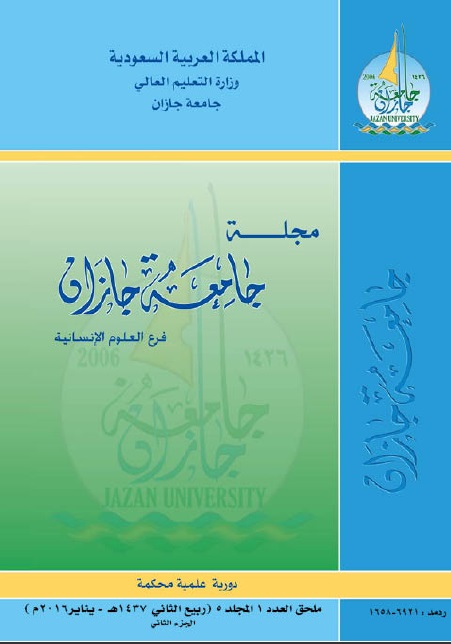الفروق الفردية القائمة على الخبرة اللغوية وأثرها على التحصيل اللغويلدى طلاب معهد تعليم اللغة العربية لغير الناطقين بها بالجامعة الإسلامية بالمدينة المنورة
Abstract
Operant Conditional leaming or the Instrumental Conditioning (Skinner) Skinner discovered that the operant conditioning or instrumental conditioning was highly efficient in animal training and was confident that it great hope of success when used with children and young people. From the operant conditioning viewpoint, teachers are regarded or seen as human engineers shaping pupils behaviour by the use of enhancement (reward) tables according to the time and distribution. Skinner believes that the goal of psychology is to predict the behaviour of individuals. and specifying it. He insists that the focus of the study of psychology is the came for morale behind) an observed behaviour. Psychology in the science of apparent behaviour and the apparent alone. Skinnet defines learning as (change in the probability of occurrence of a response) and this, in most cases is achieved through a operant conditioning And he defines operant conditioning as (the learning process in which the response becomes more likely and moer frequent and over again) Skinner believed that almost all kinds of human behaviour are a result of the reinforcement conditioning And reinforcement procedures differ, depending on the periods of separation between one twmforcement (ie swwand), and another, as the ameme of times the response occurred between them. Regarding to reinforcement based on the time periods, the piece of food peller will nor dide into the pot each time the animal prowed the leves But it does happen every three minutes or six or nine or twelve minures depending on the particular procedural arrangement. Skinner found out that the rate of responses increases whenever the reinforcement (reward) sessions within a period of time increase. The meam that the rate of responses in the case of reward at every three minutes is higher than in the case of every six minutes, and is therefore higher than the case of every nine minutes As for the other system, the reinforcement occurs after a certain number of responses predetermined by the experimenter, just like presenting the food once after every 48 pressures made on the lever, or after evety 96 pressures, or every 192 pressures. It has been observed that the response rate increases as we move towards reducing the occurence of reinforcement. Reward or remforcement is of two types: the negative and positive Definition of Renforcement. It is any stimulant that its withdrawal or appliance leads to an increased likelihood of the occurrence of a response. The Positive Remforcement: It is any stimulant that its appliance leads to the strengthening of a behaviour which is considered a prerequisite to it.As for the Negative Reinforcement: It is any stimulant that when withdrawn or excluded leads to the strengthening of a behaviour.
Is punishment reinforcement?
The punishment is a proces which is originally different from reinforcement. While reinforcement requires the provision of positive reinforcement (reward) or exclusion of a negative one, we find out that the punishment entails the provision of a negative reinforcement or the exclusion of a positive reinforcement. That means, while we define reinforcement on the basis of strengthening the response, we find that punishment is
supposed to weaken the response Types of positive reinforceпити:
There are two types of reinforcement, namely: Discrimination between stimuli, and differentiation between responses. And the entire human learning can be classified into these two kinds
1. Discriminating stimuli
The procedural discrimination is a change in behaviour resultant of changes in the environment-ie. the stimuli in which there is a living organism.
2. Differentiating responses
Skills get improved through differences in the promotion of the varying responses, for example, for you to throw a ball perfectly (like a professional) you should throw it at a suitable moment. If it is thrown or flung before or after this moment then it does not enhance or reinforce.
The difference between the clasic conditioning and the operant conditioning
1. The classical conditional learning is a stimulant response process, but the operant conditional learning is a response stimulant procedure.
2. The stimulant with significance in the operant conditional learning is that stimulant that follows the response immediately, bun in the classical conditional learning the significant stimulant is that one that precedes response.
3. The classical conditional responses are snatched or extracted responses, but the ropones leams in the operan conditional learning come trous or are derived from the animal or human responses.
4. In clasoual condnining, we inul than the corulinional simulam is specifie, such as the sound of the bell, presented by the experimenter on an on-and-off basin for a short period accompanied by the natural stimulant, but in instrumental conditioning the stimuudant is the scene, situation or position which arising and continuing 5. In classical conditioning the unconditioned stimulant is accompanied by the conditioned stimulant, regardless of what the animal is doing, Le, the reinforcement is not dependent on a certain act. But for the instrumental conditioning, the reinforcement depends on what the animal is doing, because its acts form the tool to get the reinforcement.
6. Reinforcement in the classical conditioning is the accompanying of the conditioned stimulant by the natural stimulant, but as for instrumental conditioning the reinforcement could be the stimulant such as food, water, or to escape from a painful situation, or in order to avoid an electric shock..
Downloads
Downloads
-
PDF (Arabic)
38
10
Published
Issue
Section
License
Copyright (c) 2024 CC Attribution 4.0

This work is licensed under a Creative Commons Attribution 4.0 International License.





